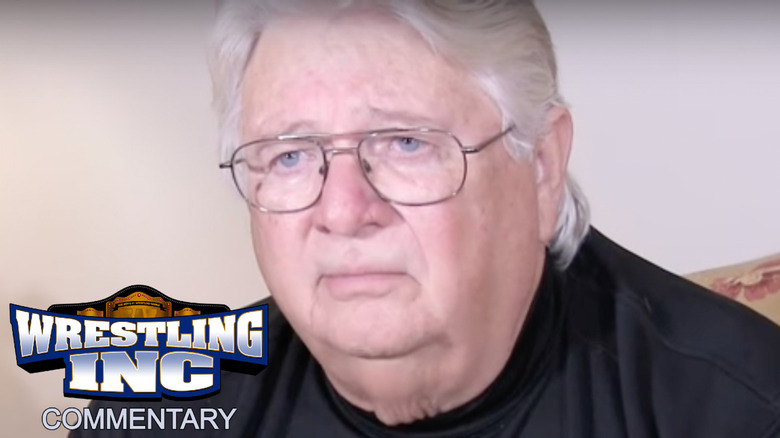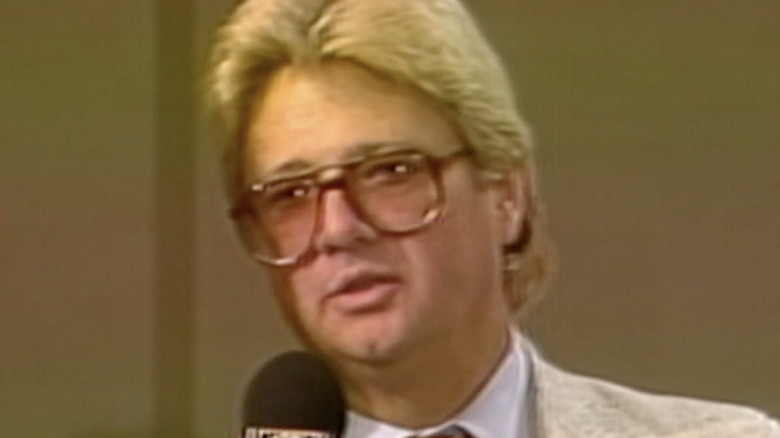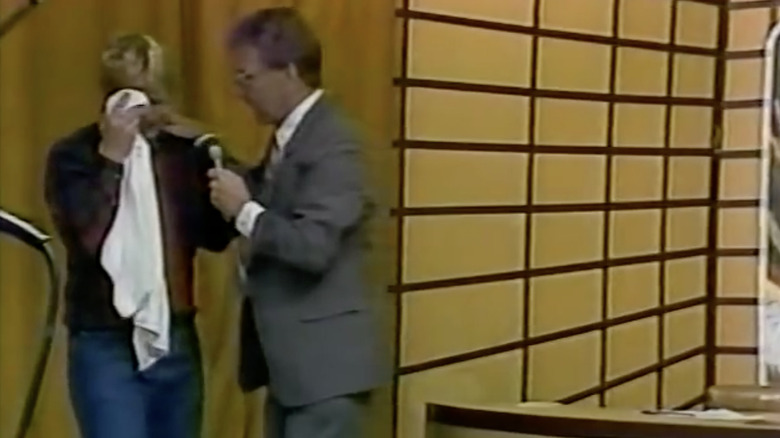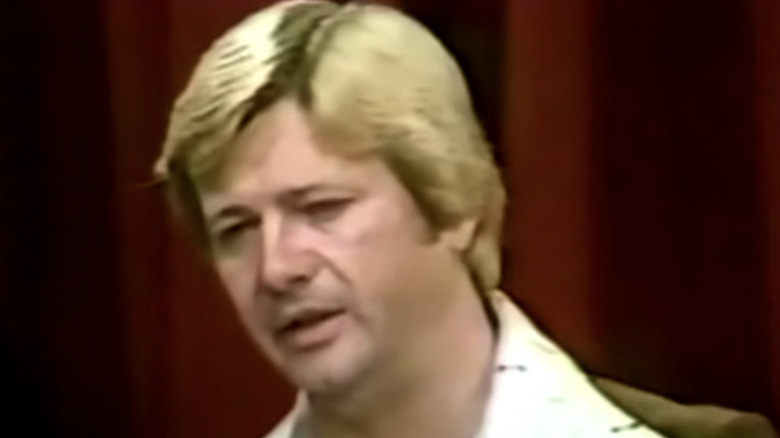Jerry Jarrett Is Responsible For The Best Wrestling TV Of All Time
News broke on Tuesday afternoon that legendary wrestler turned booker and promoter Jerry Jarrett, 80, had passed away. Though best-known by younger fans as the father of Jeff Jarrett, a founder of what's now Impact Wrestling, and the butt of Bruce Prichard's jokes on his podcast, Jerry was much more than that. His greatest influence came as a booker and promoter of what's generally referred to as the "Memphis" territorial promotion, which he owned from 1977 to 1996.
There's a lot that can be said about Jarrett's influence on wrestling, whether as a heartthrob babyface in his youth, as one of the youngest bookers in the wrestling business during the 1960s, as one of the last promoters to hang on to a regional territory, and as one of the founders of Impact. None stands out more, though, than how the Memphis style of doing a wrestling TV show became the template for modern wrestling television. Whether it was Jarrett himself as the booker or one of his proteges like Jerry Lawler, Bill Dundee, Dutch Mantell, Eddie Gilbert, Jim Cornette, and Randy Hales, Memphis wrestling was distinct, and it was easy to see the changes when someone with a Memphis background took over creative in another promotion.
If nothing else, there was one particular reason why it made sense to emulate the Memphis show: Ratings. As noted by Dave Meltzer in his obituary for Jarrett at F4WOnline.com, at its peak in the late '70s and early '80s, the live version of the show on WMC-TV in Memphis proper routinely boasted a rating (percentage of homes in the market that owned TVs) of at least 20% and a share (percentage of homes watching TV at that moment) of 70%.
The wrestling fans are the forgotten masses
"The wrestling fans are the forgotten masses," Jarrett told NBC News in 1979, giving his thoughts on his fanbase and what appealed to them to make his show so popular. "You get into the breakdown, and you find out that they are very much middle America. It's that segment that doesn't go to the Saturday football game. And most of our fans are at home, and they follow us on the television. And all you have to do is check your rating books and see a 70 share of the audience in Memphis watching wrestling on Saturday morning, and you see where they are."
Jarrett's fingerprints on the modern style of TV wrestling are most recognizable when it comes to the pacing and structure of a show. His show, which aired live for 90 minutes in Memphis and was cut down to an hour to air a week later in the rest of the territory, had a lot in common with other wrestling TV shows of the era. Most of the matches were squashes and the most important parts of the show were the interviews and angles, as the goal was to push fans to buy tickets to house shows. Where the Jarrett style differed from other territories was the sheer volume of story packed into a given show.
As a territory built around weekly shows in the main arenas, Memphis wrestling naturally had to move at a faster pace than that of a territory like the old WWF, where the major arenas were run monthly. But other weekly territories did not present the kind of soap opera that Memphis did.
'Personal issues draw money'
To best illustrate the structure of Jarrett-style TV and how it's carried over to modern wrestling, let's look at a show that not only features Jerry Jarrett as a performer, but is also widely viewed as one of the best episodes of wrestling television in the history of the genre, exemplifying the mantra emblazoned on a sign on his office desk: "Personal issues draw money."
The March 1, 1986 show came two months removed from Jerry Lawler had unjustly dropping a "loser leaves town" match to Bill Dundee, barring him from wrestling in the territory. (He went on a working vacation in Hawaii while he was gone.) In the interim, the top heels — Dundee, Buddy Landel, and Dutch Mantel — ran roughshod over everyone, albeit with Mantel having just turned babyface a couple weeks earlier.
The stage is set by a pre-recorded Mantel interview early in the show, but it heats up about a third of the way through, when Dundee and Landel continue to attack their opponents after winning a squash match. The referee, 18 year old Jeff Jarrett — Jerry's son — tries to intervene, only to get attacked for his trouble. This leads to Jerry, the promoter, running in to make the save. The heels outnumbered him, went after his lone good eye, and Jeff recovered enough to try to save him, only to get badly beaten himself. Only a barely-dressed Mantel finally running in could end the chaos. After the break, Jerry interrupted the schedule match. He was so emotional that he could barely talk through his tears. He was followed by fellow promoter/his father-in-law/Jeff's stepfather-in-law, Eddie Marlin, who said he had to bring back Lawler to stop Dundee and Landel.
After the next match, the start of which was interrupted by those promos, they jury-rigged a way to call Lawler on the air and made Lawler and Mantel vs. Dundee and Landel the main event for two nights later, Dundee's lawyers be damned.
Pro wrestling was less of a soap opera before Jerry Jarrett
Yes, the March 1, 1986 Memphis show is particularly dense, storytelling-wise, for a single feud, and not the norm. But it's instructive for all of the ways that the Jarrett/Memphis style of television was different and laid the groundwork for the likes of "WWE Raw."
The Memphis show was much more overtly presented as a television first product that other wrestling TV shows, even ones that were shot in small television studios. Wrestlers complaining about rivals butting into their allotted time in the show format was a routine matter. The last match of the show was always an "expiration of time" match, where whoever scored the most falls until the expiration of TV time won the match, a concept that could only be part of a TV show. So when the format was broken in a big way, which was not something other wrestling shows did, it had a major impact. Whether it's the promoter crying because he couldn't protect his son or the show slowing so a phone call could be made on the air, that kind of shift from the week to week format for major angles was not the norm outside of Memphis until long after this.
Stories that weaved their way throughout a whole show were also much less common before Jarrett, and it shows. As much as Mid-South Wrestling (available on WWE Network/Peacock) is lauded for it meticulous storytelling and episodic booking under Bill Watts's leadership, it was much less of a story-heavy soap opera before Jarrett sent Dundee to work for Watts as his booker. The same went in Dallas, Texas: Though World Class Championship Wrestling innovated other areas of the TV presentation, it was Jarrett taking over the company in 1988 that saw the promotion shift towards a more interview and angle-heavy style of television. Even the WWF went in a more episodic direction than before when Jim Cornette, a Jarrett protégé, joined the creative team in 1996.
Without Jerry Jarrett, wrestling on TV as we know it looks a lot different.



